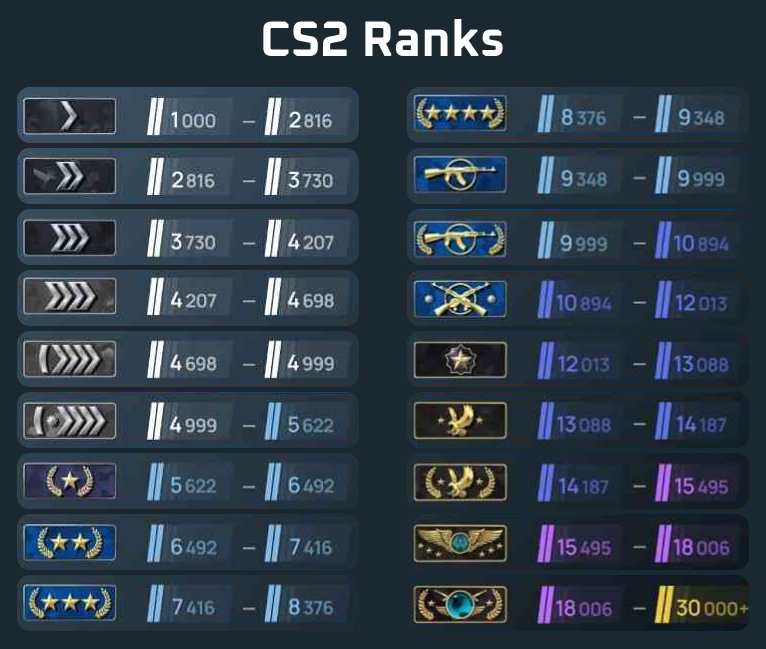Counter-Strike’s competitive ranking system is one of the most robust skill-based matchmaking systems in competitive gaming. This guide breaks down exactly how ranks work, what influences them, and how to progress through the ranking system effectively.
Understanding the CS Ranking System

Counter-Strike uses the Glicko-2 rating system to evaluate player performance and assign ranks. This system processes multiple performance metrics including round wins, MVPs, and overall match outcomes to determine a player’s skill level and appropriate rank.
The Complete Rank Hierarchy:
Here’s the full breakdown of CS ranks from lowest to highest:
- Silver Ranks
- Silver |
- Silver I|
- Silver I||
- Silver IV
- Silver Elite
- Silver Elite Master
- Gold Nova Ranks
- Gold Nova I
- Gold Nova II
- Gold Nova III
- Gold Nova Master
- Master Guardian Ranks
- Master Guardian I
- Master Guardian II
- Master Guardian Elite
- Distinguished Master Guardian
- Elite Ranks
- Legendary Eagle
- Legendary Eagle Master
- Supreme Master First Class
- Global Elite
How Rank Progression Works
Rank progression in Counter-Strike is determined by multiple performance factors that the system tracks across your competitive matches. Understanding these factors is crucial for rank improvement.
Key ranking factors:
- Match outcomes (wins/losses)
- Personal performance metrics
- Round win contributions
- MVP awards
- Consistency across matches
- Quality of opposition
- Performance against higher/lower ranked players
Frequently Asked Questions
Q: What’s the highest rank in CS2?
Global Elite is the highest achievable rank, representing approximately the top 1% of the player base.
Q: What’s the average rank in CS2?
The average player rank typically falls in the Gold Nova ranks, though this can fluctuate based on region and player population.
Q: How many wins are needed to rank up?
There’s no fixed number, but players typically need 5-20 matches with consistent performance to advance ranks, depending on current performance level and opposition quality.
Q: Do ranks decay?
Yes, extended periods of inactivity can result in rank decay, requiring a recalibration match to restore or reassess rank.
Performance Metrics and Rank Assessment
The ranking system evaluates:
- Rounds won vs rounds lost
- MVP stars earned
- Performance against higher/lower ranked opponents
- Consistency across matches
- Personal score and impact
Conclusion
Success in Counter-Strike’s ranking system comes from consistent performance improvement and understanding of game mechanics. Focus on measurable improvements in aim, game sense, and team play. Track your progress, analyze your matches, and maintain a consistent practice routine.
Regular competitive play combined with deliberate practice in key areas will naturally lead to rank progression. The most effective approach is focusing on improvement rather than the rank itself.
For players managing cs2 inventories, our guide on CS:GO cashout options provides safe and efficient review.
And for players interested in trading up your skins, here are all the trading sites that in cs2 exists: CS:GO trading.
Sources: csgo.cz, totalcsgo.com
